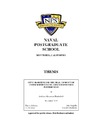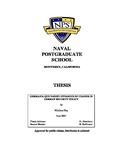German battle style in ultra mobile, high intensity war: North African Desert 1941-42
| dc.contributor.author | Stolfi, Russel H. S. | |
| dc.date | [n.d.] | |
| dc.date.accessioned | 2014-12-16T23:23:15Z | |
| dc.date.available | 2014-12-16T23:23:15Z | |
| dc.date.issued | 1991 | |
| dc.identifier.uri | https://hdl.handle.net/10945/44198 | |
| dc.description | Unpublished manuscript. Contains notations by author. Date is approximate. Document ends at page 84. | en_US |
| dc.description.abstract | The German Army fought battles in World Wars I and II more effectively than any other armed force. Other great Armires -- British, French, American and Russian -- fought against the Germans with estimable battle fighting skill among commanders and combat soldiers. Those Armies also fought with weapons similar in technological performance characteristics to those of the Germans. The German Army, however, linked tactics and operations with weapons in combinations that gave it more impressive victories on the strategic offensive and dangerous vigor on the strategic defensive than its respected opponents. The German Army possessed an edge in war fighting that remains to this day difficult to qualify but nevertheless a tangible, superiority over the other great Armies of the world. This brief study searches for insights into what made the German Army tick: the style of the commanders and the spirit that drove the combat soldiers. The purpose of the study is to present the insights and make recommendations on how the associated German style of fighting might be applied to improve U. S. Marine Corps operations today. (from the Preface) | en_US |
| dc.format.extent | 84p. | en_US |
| dc.rights | This publication is a work of the U.S. Government as defined in Title 17, United States Code, Section 101. Copyright protection is not available for this work in the United States. | en_US |
| dc.title | German battle style in ultra mobile, high intensity war: North African Desert 1941-42 | en_US |
| dc.type | Article | en_US |
| dc.contributor.corporate | U.S. Naval Postgraduate School, Monterey California |





